Ad Astra - Oppdagerne #108 Traditional Geocache
Ostara74: Denne er vekk igjen. This one is gone again.
Ad Astra - Oppdagerne #108
-
Difficulty:
-

-
Terrain:
-

Size:  (regular)
(regular)
Please note Use of geocaching.com services is subject to the terms and conditions
in our disclaimer.
Ad Astra - Oppdagerne #108
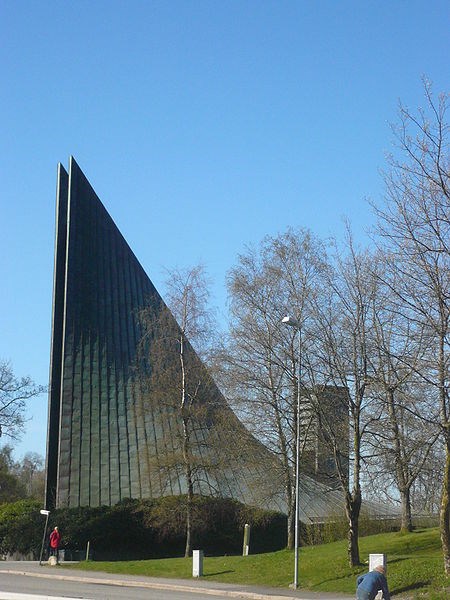
English translation below
Slettebakken kirke ble påbegynt i 1968 og stod ferdig i 1970. Tegnet av arkitekt Tore Sveram. Han fikk oppdraget i 1964 etter å ha vunnet en lokal arkitektkonkuranse om kirkebygget. Kirken fikk navnet "Ad Astra" - som betyr "Mot Stjernene"
Selve kirkebygget var på den tiden - og er fortsatt et radikalt kirkebygg. Arkitekten møtte mye motstand hos Bergen Kommune, men menigheten likte derimot forslaget.
I "Arkitekturguide Bergen", utgitt av Bergens Tidende i 2008 i samarbeid med Bergen Arkitektforening er kirken beskrevet slik:
"Betongkirke i vifteform som er elegant plassert i landskapet. Sjeldent fint samspill mellom eksteriør og interiør. Resultat av arkitektkonkurranse der Tore Sverams forslag ble kåret som vinner. Grunnstein nedlagt 1968. Innviet 1970. Kirken er fredet."
Slettebakken kirke ble valgt som motiv på Den Norske Kirkes jubileumsfrimerke fra 1000-års feiringen i 1995, som representant for en kirke fra vår samtid.
Selv om kirken ble åpnet i 1970, var ikke kirken ferdig utsmykket innvendig før i 1997. Dette var av økonomiske årsaker.
Utsmykking
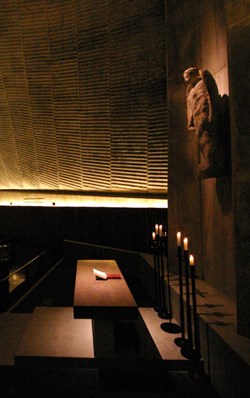
![]()
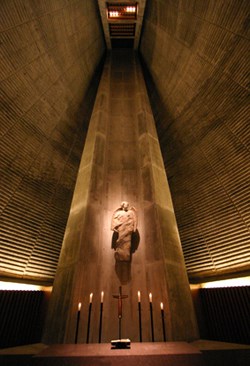
Budbringeren
Arkitekten samarbeidet med en svensk kunstner (Palle Pernevi) som skulle fremstille et kunstverk som skulle plasseres på betongsøylen bak alteret inni kirken. Avgjørelsen dro ut i tid og kunstneren trakk seg etter hvert fra prosjektet grunnet dette. I 1997 kom "Budbringeren" av kunstneren Kristian Blystad på plass. Dette er en engel i granitt med forgylte partier. Granitten har forskjellige huggings- og slipingsgrader som gjør at lyset fanges ulikt. Forgyllingen er også lagt på baksiden som er opplyst slik at skulpturen fremstår med en varm, strålende "corona" mot søylen.
Etter dette har det også kommet på plass en lysglobe, dåpslysestake, nye blomstervaser på alteret - alt laget av Pål Vigeland (Kunstner) i 2004. Tekstiler på prekestolen og liturgiske klær kom på plass i 2005-2006 og ble fremstilt av Laila Endresen (Tekstilkunstner).
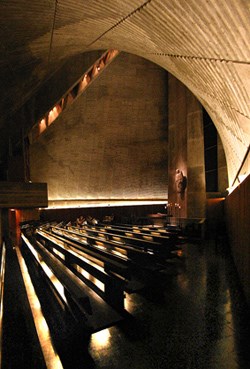
![]()
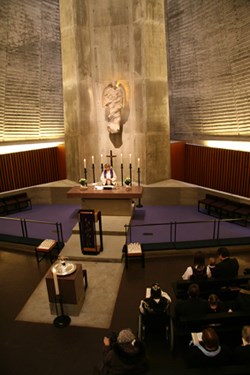
Slettebakken Church
Slettebakken church was begun in 1968 and completed in 1970. Designed by architect Tore Sveram. He got the job in 1964 after winning a local architectural competition for the church building. The church was named "Ad Astra" - which means "To the stars"
The church building was at the time - and still is a radical church. The architect met much resistance in Bergen County, but the congregation loved the proposal.
In "Architecture Guide Bergen", published by the regional newspaper Bergens Tidende in 2008 in cooperation with the Bergen Association of Architects, the church is described as follows:
"Concrete Church in fan shape, elegantly placed in the landscape. Rarely fine interplay between exterior and interior. results of the architectural competition Tore Sverams proposal was voted the winner. Basics closed 1968. Inaugurated 1970. Church is listed."
Slettebakken Church was chosen as the scene of the Norwegian Church commemorative stamp from the 1000-year celebration in 1995, as a representative of a church of our time.
Although the church was opened in 1970, the church was not completed embellished the interior until 1997. This was for economic reasons.
Arts and decorations
The architect worked with a Swedish artist (Palle Pernevi) that would produce a work of art that was placed on a concrete pillar behind the altar in the church. The decision came out in time and the artist withdrew from the project due to this. In 1997 came "The Messenger" of the artist Kristian Blystad in place. This is an angel in granite with gold plated parts. Granite have different chopping and grinding degree that allows the light to be captured differently. Gilding is also placed on the back that is illuminated so that the sculpture appears with a warm, radiant "corona" against the pillar.
After this, it has also been in place a lightglobe, babtism canlestick, new flower vases on the altar - all designed by Pål Vigeland (artist) in 2004. Textiles on the pulpit and liturgical clothing was in place in 2005-2006 and was produced by Laila Endresen (textile artist).
Additional Hints
(Decrypt)
FR pbeare bs orq jvgu pureel ynhery //FØ uwøear ni oybzfgreorq zrq ynheoæeurtt